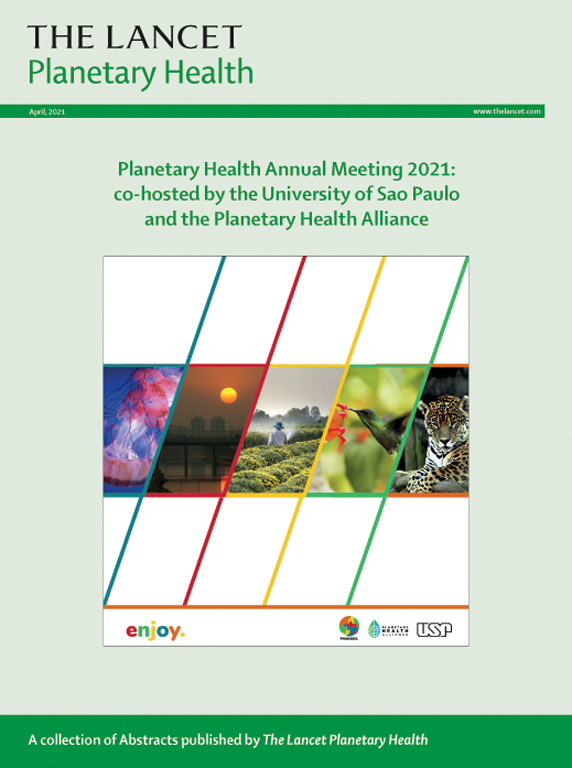The impacts of air pollution on mortality and hospital readmission among Medicare beneficiaries with Alzheimer's disease and Alzheimer's disease-related dementias: a national retrospective cohort study in the USA
IF 24.1
1区 医学
Q1 ENVIRONMENTAL SCIENCES
引用次数: 0
Abstract
Background
Alzheimer's disease and Alzheimer's disease-related dementias (AD/ADRD) are prevalent neurodegenerative disorders, posing a critical worldwide public health challenge. Ambient air pollution has been identified as a potential risk factor for AD progression based on toxicological and epidemiological studies. We aimed to evaluate the impacts of air pollution—including fine particulate matter (PM2·5), nitrogen dioxide (NO2), summer ozone (O3), and oxidant—on readmission or death among Medicare enrollees previously hospitalised with an AD/ADRD diagnosis code.
Methods
We constructed a population-based nationwide retrospective cohort including all Medicare fee-for-service beneficiaries (aged ≥65 years) in the contiguous USA (2000–16) hospitalised with AD/ADRD, and followed them up from the year after their first hospitalisation until (1) year of death (mortality cohort) and (2) year of second hospitalisation for any cause (readmission cohort). We calculated annual average PM2·5, NO2, summer O3, and oxidant concentrations for each individual at their residential ZIP code in each year after their first hospitalisation with AD/ADRD. We applied Cox proportional hazard models for the mortality and readmission cohorts stratifying on individual risk factors and adjusting for socioeconomic status, seasonal temperatures, and relative humidity.
Findings
Our cohort consisted of 5 544 118 individuals, of whom 4 543 759 (82·0%) died and 3 880 894 (70·0%) were readmitted to the hospital during the study period. The average follow-up times were 3·34 years (SD 2·60) for the mortality cohort and 1·98 years (SD 1·65) for the readmission cohort. In both the mortality and readmission cohorts we found significant associations with each pollutant. For an IQR increase in NO2, we found a hazard ratio (HR) for mortality of 1·012 (95% CI 1·009–1·015) and an HR for readmission of 1·110 (1·104–1·117). In the readmission cohort, we found an HR of 1·084 (1·079–1·089) for an IQR increase (3·87 μg/m3) in PM2·5. The results slightly decreased in multi-pollutant models. The results of effect modification for mortality and readmission varied by pollutant, but higher risks were found among Black males and among those eligible for Medicaid in general.
Interpretation
We provide new evidence that among a susceptible population with previous AD/ADRD-related hospitalisations, annual air pollution exposure since first hospitalisation is associated with risk of readmission and death.
Funding
National Institute on Aging.
空气污染对阿尔茨海默病和阿尔茨海默病相关痴呆的医疗保险受益人死亡率和再入院率的影响:美国的一项全国性回顾性队列研究
阿尔茨海默病和阿尔茨海默病相关痴呆(AD/ADRD)是一种常见的神经退行性疾病,对全球公共卫生构成了重大挑战。根据毒理学和流行病学研究,环境空气污染已被确定为阿尔茨海默病进展的潜在危险因素。我们旨在评估空气污染——包括细颗粒物(PM2·5)、二氧化氮(NO2)、夏季臭氧(O3)和氧化剂——对先前因AD/ADRD诊断码住院的Medicare参保者再入院或死亡的影响。方法:我们构建了一个以人群为基础的全国回顾性队列,包括美国连续地区(2000 - 2016年)所有因AD/ADRD住院的医疗保险有偿服务受益人(年龄≥65岁),并从他们首次住院后一年开始随访,直到(1)死亡年份(死亡率队列)和(2)任何原因第二次住院年份(再入院队列)。我们计算了每位患者首次因AD/ADRD住院后,其居住邮政编码地区每年的年均PM2·5、NO2、夏季O3和氧化剂浓度。我们对死亡率和再入院队列应用Cox比例风险模型,对个体风险因素进行分层,并根据社会经济地位、季节温度和相对湿度进行调整。本研究共纳入5 544 118例患者,其中4 543 759例(82%)死亡,3 880 894例(70%)再次入院。死亡组的平均随访时间为3.34年(SD 2.60),再入院组的平均随访时间为1.98年(SD 1.65)。在死亡率和再入院队列中,我们发现了与每种污染物的显著关联。对于IQR中NO2的增加,我们发现死亡率的风险比(HR)为1.012 (95% CI为1.009 - 1.015),再入院的风险比(HR)为1.110(1.104 - 1.117)。在再入院队列中,我们发现PM2·5中IQR增加(3.87 μg/m3)的HR为1.084(1.079 - 1.089)。在多污染物模型中,结果略有下降。死亡率和再入院的影响修正结果因污染物而异,但在黑人男性和一般有资格享受医疗补助的人群中发现了更高的风险。解释:我们提供了新的证据,表明在有AD/ adrd相关住院史的易感人群中,自首次住院以来的年度空气污染暴露与再入院和死亡风险相关。资助国家老龄研究所。
本文章由计算机程序翻译,如有差异,请以英文原文为准。
求助全文
约1分钟内获得全文
求助全文
来源期刊

Lancet Planetary Health
Multiple-
CiteScore
28.40
自引率
2.30%
发文量
272
审稿时长
8 weeks
期刊介绍:
The Lancet Planetary Health is a gold Open Access journal dedicated to investigating and addressing the multifaceted determinants of healthy human civilizations and their impact on natural systems. Positioned as a key player in sustainable development, the journal covers a broad, interdisciplinary scope, encompassing areas such as poverty, nutrition, gender equity, water and sanitation, energy, economic growth, industrialization, inequality, urbanization, human consumption and production, climate change, ocean health, land use, peace, and justice.
With a commitment to publishing high-quality research, comment, and correspondence, it aims to be the leading journal for sustainable development in the face of unprecedented dangers and threats.
 求助内容:
求助内容: 应助结果提醒方式:
应助结果提醒方式:


